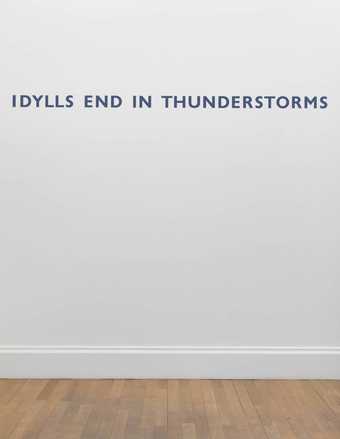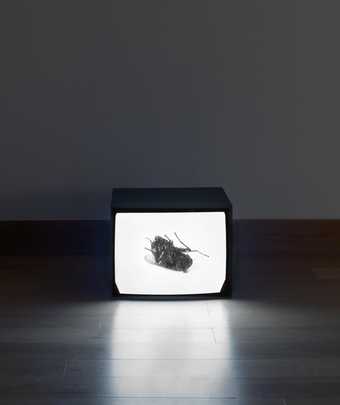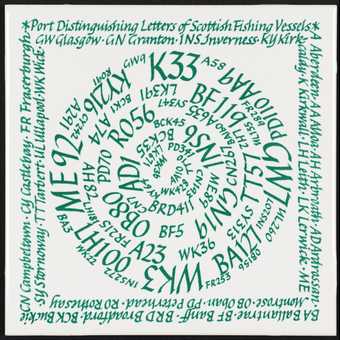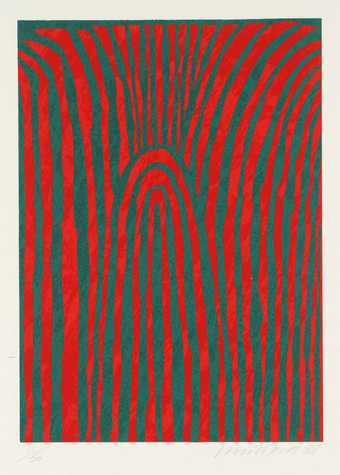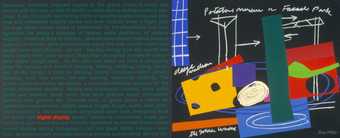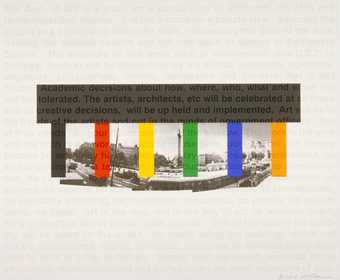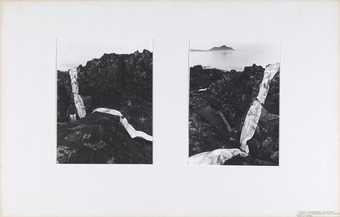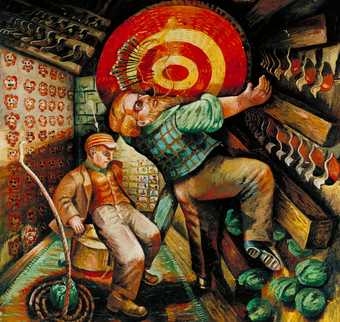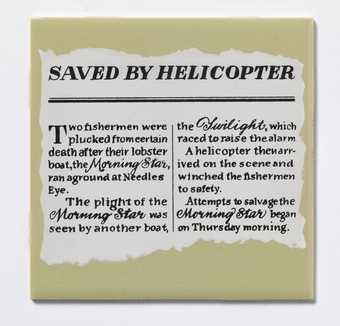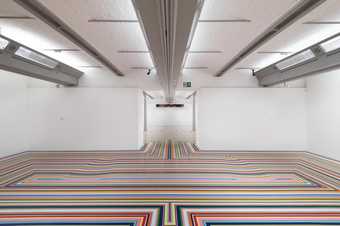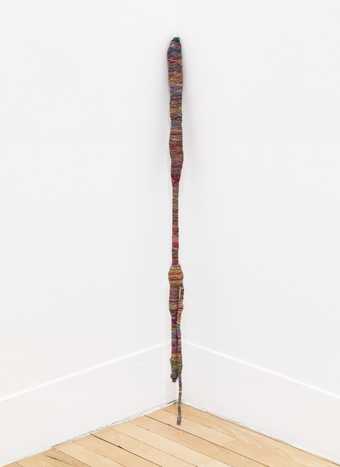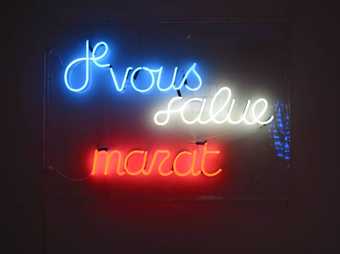In Tate Britain
Material as Message
Free- Artist
- Anya Gallaccio born 1963
- Medium
- 2000 gerberas, glass, metal and rubber
- Dimensions
- Displayed: 2600 × 5350 × 25 mm
- Collection
- Tate
- Acquisition
- Presented by an anonymous donor 2004
- Reference
- T11829
Summary
preserve ‘beauty’ is an installation work composed of bright red flowers arranged in four adjacent rectangular compositions underneath large panes of clear glass. The flowers are presented in a single layer with their heads facing out towards the viewer, and their stalks are positioned downwards, so that the lower edge of each panel features a band of green made up of the stems of the bottom row of flowers. The type of flower used in the installation is a hybrid between a gerbera and a daisy that is known by the name ‘beauty’. During the period in which preserve ‘beauty’ is displayed, the flowers wither and die, and this decay process is visible to viewers through the glass. Due to the shrinkage of the flowers as they rot, the glass panels require adjustment over the period of display, and the dead flowers often fall out of the glass and decompose further on the floor. Viewers experience the installation through their sense of smell, as well as visually: they encounter either the smell of the flowers when they are fresh or their rotting odour as they decay, depending on the amount of time that has lapsed since the work was put on display.
The work was made by the British conceptual artist Anya Gallaccio in 1991 for an installation in the window of Karsten Schubert gallery in London. For this display, Gallaccio used eight hundred flowers and compressed them between the gallery window and a single plane of glass, so that the flowers faced outwards for passersby to see. The natural decay that the flowers undergo over time means that Gallacio has reassembled the work many times since 1991, and in different locations. To install the work each time, Gallaccio lays one of the glass panels on the floor, arranging the flowers in rows and attaching them to the glass with long pieces of dental floss. The panels are then raised vertically and secured to the wall, and the dental floss is cut and removed, leaving the flowers in place. The number of flowers used each time varies, but Gallaccio generally includes between sixteen hundred and two thousand for each installation, depending on the sizes of the flowers’ heads.
Gallaccio has made several installations throughout her career that incorporate materials which decay over time, including ice, fruit and sugar, as well as other works using real flowers. The title of this installation makes reference to the act of preservation that Gallaccio carries out by placing her flowers under glass. It also employs the double meaning of the word ‘beauty’ – referring to the name of the type of flower and the concept of beauty in general. Gallaccio used this title formulation for another 1991 work, preserve ‘cheerfulness’, which is a much larger work consisting of more than eight thousand narcissus flowers pressed between two six-foot-square panes of glass and laid on the floor. When viewed with their titles in mind, especially when the flowers have begun to decay, these works suggest that positive experiences such as those of beauty and cheerfulness are by their nature temporary, and that attempts to preserve them may be futile.
Positioned neatly behind glass, the flowers in preserve ‘beauty’ recall still-life and romantic landscape paintings, as well as traditionally feminine pursuits such as flower arranging and pressing. Gallaccio has described the gerbera daisies she uses as a type of readymade – an everyday, often mass-produced object that is made extraordinary through appropriation by an artist for use in an installation (Horlock, Reitmaier and Schama 2002, p.43). As the curator Ralph Rugoff has observed, ‘[s]centless and mass-produced all year round as disposable commodities, there is in fact little that is “natural” about gerberas’ (Rugoff 1999, p.12). Gallaccio’s work focuses on this overlap between commodity culture and natural objects, specifically in relation to the wastage and decay that is usually hidden from consumers. In an interview in 2000 she stated that: ‘[w]e experience so much of the world at a mediated and sanitised distance, so I try to make art that is not complicit with this structure’ (Gallaccio 2000, p.3).
Given the ephemeral nature of the flowers used in preserve ‘beauty’, the appearance of the work changes continuously as a consequence of organic processes that are beyond the control of the artist or the viewer. Both parties act as witnesses to the work’s inevitable decomposition, and as such preserve ‘beauty’ can be understood as a kind of performance. Gallaccio has described her work as ‘theatrical’, claiming that ‘[w]hat interests me is the performance between myself and the material and being alive to the particularities of each individual opportunity’ (Gallaccio 2000, p.3). Accordingly, Gallaccio does not see herself as the sole ‘author’ of her work, and instead views installations such as preserve ‘beauty’ as a temporary collaborations between her and the viewer that invite reflection on the themes of ‘place, time, life, decay, death, beauty and renewal’ (Gallaccio 2000, p.3).
Further reading
Ralph Rugoff, Anya Gallaccio: Chasing Rainbows, Glasgow and Newcastle-upon-Tyne 1999, reproduced pp.40–1.
Anya Gallaccio, ‘Response to a Space’, a-n (For Artists), November 2000, p.3.
Mary Horlock, Heidi Reitmaier and Simon Schama, Anya Gallaccio: Beat, London 2002, reproduced p.41.
Fiona Anderson
May 2014
Supported by Christie’s.
Does this text contain inaccurate information or language that you feel we should improve or change? We would like to hear from you.
Display caption
Gallaccio works with organic, perishable materials such as ice, flowers, fruits and sugar. This installation challenges romantic ideas associated with flowers and our relationship to nature. Gallaccio has described cut flowers as a mass-produced ‘disposable commodity’. The word ‘beauty’ in the title refers to a variety of cultivated gerbera. It is also a play on words, as the flowers are left to wither and rot. Gallaccio calls her work a ‘performance between myself and the material’. She says it is a collaboration with the viewers experiencing this temporary artwork.
Gallery label, January 2020
Does this text contain inaccurate information or language that you feel we should improve or change? We would like to hear from you.
Technique and condition
Four clear glass panels compressing flowers against a wall. The panels are secured to the wall with metal and rubber fixings.
Fresh flowers are used for each new installation; these are allowed to decay during the display period. The flowers are gerberas – red petals with a dark centre, hybrid name: ‘Beauty’. The number of flowers required varies between 1600 and 2000 according to the size of the flower heads.
For display, the flowers are arranged in rows and tied to the back of the panels with dental floss while the panels lie flat; the panels are then raised quickly and fixed to the wall pressing the flowers just enough to stay in position; the dental floss is cut and carefully removed leaving the flowers in place. The glass panels have to be adjusted during the display to allow for the shrinking of the flowers. Any fallen flowers are left in place but all the flowers are discarded at the end of each display.
There is no finish to the glass panels and the only marks and inscriptions present are the kite marks.
The glass panels are in a good condition.
Sasa Kosinova
August 2005
Explore
- abstraction(8,615)
-
- non-representational(6,161)
-
- colour(2,481)
- universal concepts(6,387)
-
- beauty(1,484)
- decay(254)
- environment / nature(315)
- birth to death(1,472)
-
- stages of life(79)
You might like
-
Ian Hamilton Finlay IDYLLS END IN THUNDERSTORMS
1986 -
Douglas Gordon Film Noir (Fly)
2008 -
Ian Hamilton Finlay Midway (‘Through a Dark Wood’)
1976 -
Ian Hamilton Finlay Port-Distinguishing Letters of Scottish Fishing Vessels [collaboration with George L Thomson]
1976 -
Bruce McLean Hot Slick
1989 -
Kate Whiteford Untitled
1988 -
Bruce McLean Facade Park
1998 -
Bruce McLean Great Arch of Art
1998 -
Alan Michael Flags at Le Havre
2008 -
Bruce McLean 2 Rock and Shoreskapes, Largiebeg
1969 -
Steven Campbell The Dangerous Early and Late Life of Lytton Strachey
1985 -
Ian Hamilton Finlay The Four Seasons
1975–6 -
Jim Lambie Zobop
1999, remade on installation -
Jim Lambie Psychedelic Soulstick
1999 -
Ian Hamilton Finlay Je Vous Salue Marat
1989


